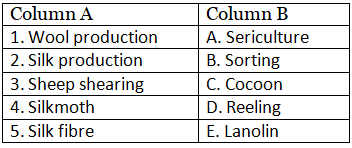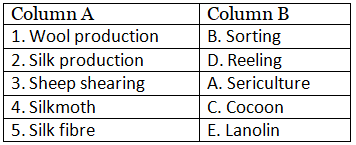Worksheets With Solutions: Fibre to Fabric Class 5 Worksheet EVS
| Table of contents |

|
| Section A: Multiple Choice Questions (Easy) |

|
| Section B: Short Questions (Medium) |

|
| Section C: Fill in the blanks |

|
| Section D: Match the column |

|
| Section E: True or False |

|
Section A: Multiple Choice Questions (Easy)
Q.1. Which animal provides wool?
(a) Goat
(b) Sheep
(c) Cow
(d) Horse
Correct Answer is Option (b)
Sheep are the most common animal that provides wool.
Q.2. Which of the following is not a stage in wool production?
(a) Shearing
(b) Scouring
(c) Spinning
(d) Cooking
Correct Answer is Option (d)
Cooking is not a stage in wool production.
Q.3. Which of the following is a health hazard in the wool industry?
(a) Noise pollution
(b) Air pollution
(c) Water pollution
(d) Land pollution
Correct Answer is Option (b)
The wool industry produces a lot of dust, which can lead to air pollution.
Q.4. Which of the following is an animal that produces silk?
(a) Sheep
(b) Goat
(c) Silkworm
(d) Cow
Correct Answer is Option (c)
Silkworms are the animal that produces silk.
Q.5. Which of the following is not a stage in sericulture?
(a) Harvesting
(b) Spinning
(c) Weaving
(d) Cultivation
Correct Answer is Option (d)
Cultivation is not a stage in sericulture.
Section B: Short Questions (Medium)
Q.1. What are the different types of wool available in the market?
The different types of wool available in the market are merino, cashmere, mohair, and angora.
Q.2. Explain the process of scouring in wool production.
Scouring is the process of washing the raw wool to remove dirt, grease, and other impurities.
Q.3. What are the health hazards in the wool industry and how can they be prevented?
The health hazards in the wool industry include respiratory problems, skin irritation, and hearing loss. These can be prevented by wearing protective clothing, using ventilation systems, and taking breaks.
Q.4. Describe the life cycle of a silkworm.
The life cycle of a silkworm includes the egg stage, larva stage, pupa stage, and adult stage.
Q.5. What are the different types of silk available in the market?
The different types of silk available in the market are mulberry silk, tussar silk, and eri silk.
Section C: Fill in the blanks
Q.1. Wool is derived from the fleece of ____________.
Wool is derived from the fleece of Sheep.
Q.2. The process of removing wool from the body of a sheep is called ____________.
The process of removing wool from the body of a sheep is called Shearing.
Q.3. The process of sorting fleece into different categories based on their quality is called ____________.
The process of sorting fleece into different categories based on their quality is called sorting.
Q.4. ____________ is an insect which feeds on the leaves of mulberry trees and produces silk.
Silkworm is an insect which feeds on the leaves of mulberry trees and produces silk.
Q.5. The process of rearing silkworms for the production of silk is called ____________.
The process of rearing silkworms for the production of silk is called sericulture.
Section D: Match the column
Match the items in Column A with those in Column B

1. Wool production involves sorting.
2. Silk production involves reeling.
3. Sheep shearing is the process of removing wool from the body of a sheep.
4. Silkmoth is the insect which produces silk.
5. Silk fibre is obtained by reeling the cocoon.
Section E: True or False
Q.1. Wool is a synthetic fibre.
False
Wool is a natural fibre, not synthetic.
Q.2. Shearing is a painful process for sheep.
False
Shearing is not a painful process for sheep if done correctly.
Q.3. Sorting is done to separate wool into different colours.
False
Sorting is done to separate wool based on quality, not colour.
Q.4. Silkworms are caterpillars of a moth.
True
Silkworms are the caterpillars of a moth.
Q.5. Silk fibre is obtained from the cocoon of a silkworm.
True
Silk fibre is obtained from the cocoon of the silkworm.
|
139 videos|151 docs|18 tests
|
















